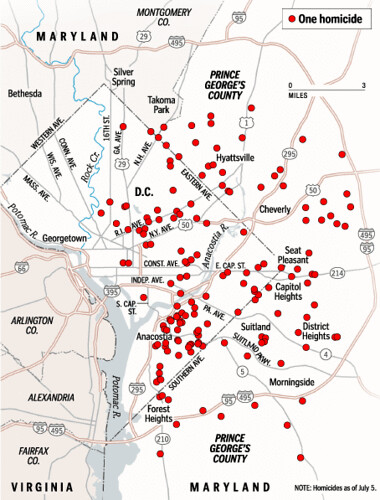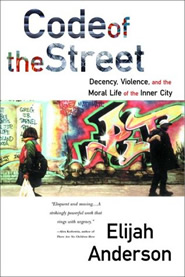I don't read the Post first thing in the morning...
 The border between Prince George's County and the District is a high-crime area. The map shows where homicides have taken place this year in the two jursidictions inside the Capital Beltway. Graphic by Richard Furno, Nathaniel Vaughn Kelso and Tiffany Sakato, THE WASHINGTON POST.
The border between Prince George's County and the District is a high-crime area. The map shows where homicides have taken place this year in the two jursidictions inside the Capital Beltway. Graphic by Richard Furno, Nathaniel Vaughn Kelso and Tiffany Sakato, THE WASHINGTON POST....Or I would have known that while I was writing the previous entry about the increase in crime in Prince George's County (comparing it to a similar situation in the San Francisco Bay area), that the Post has an article in today's paper about the same subject--"Living on Edge of Violence: District-Prince George's Border Is Region's Most Dangerous Area."
I do think the article misses the point by focusing on the border, and not the demographics of the area on either side of the border, particularly those areas experiencing high-rates of violent crime.
The quote in the article from DC's MPD Chief Ramsey is closer to the truth: "But others disagree. D.C. Police Chief Charles H. Ramsey and homicide detectives said the killings do not seem to cross the boundaries as often as in the past. "Crime is a localized problem," Ramsey said. "A lot of the homicides, in particular, are about retaliation or arguments. Those things tend to happen in places you live or frequent."
The Post wrote about more about this earlier in the year, I just didn't link to those articles. The editorial, "An Epidemic of Murder", discusses the issues, as well as problems within the Prince George's Police Department:
"THE UNSETTLING spike in homicides in Prince George's County -- against a backdrop of a declining murder rate in the District -- is the subject of varying analyses and explanations, all of which may hold some truth. Many think the understaffed Prince George's police department cannot cope with the county's increasingly urban crime problems. Some believe that the District's gentrification is driving lower-income people, including criminals, across the border into the county. There are concerns, too, that the juvenile justice system is a revolving door far more likely to deposit hardened young offenders back on the street, and into a snake pit of weapons, drugs, gangs and crime, than to rehabilitate them.
Somewhere, I know that I read an analysis of the first 30 or so murders this year in Prince George's County. I can't find the article now, perhaps it was from the Gazette, which I look at only occasionally. I was struck by the report because most of the murders were not really drug-related at all, if the description of events was to be believed--most seemed to be the result of various and sundry disputes.
This gets back to something I mention all the time, the work (Streetwise and Code of the Streets) of Elijah Anderson, a sociologist at the University of Pennsylvania. Long before the book Code of the Streets was published, the arguments were summarized in an article in The Atlantic Magazine (May 1994 v273 n5 p80). The article is no longer freely accessible, but you can always read the book (at the MLK Library) or access the article via articles databases at the library.

From the article:
In this essay in urban anthropology a social scientist takes us inside a world most of us only glimpse in grisly headlines--"Teen Killed in Drive-By Shooting"--to show us how a desperate search for respect governs social relations among many African-American young men.
Of all the problems besetting the poor inner-city black community, none is more pressing than that of interpersonal violence and aggression. It wreaks havoc daily with the lives of community residents and increasingly spills over into downtown and residential middle-class areas. Muggings, burglaries, carjackings, and drug-related shootings, all of which may leave their victims or innocent bystanders dead, are now common enough to concern all urban and many suburban residents. The inclination to violence springs from the circumstances of life among the ghetto poor--the lack of jobs that pay a living wage, the stigma of race, the fallout from rampant drug use and drug trafficking, and the resulting alienation and lack of hope for the future.
Simply living in such an environment places young people at special risk of falling victim to aggressive behavior. Although there are often forces in the community which can counteract the negative influences, by far the most powerful being a strong, loving, "decent" (as inner-city residents put it) family committed to middle-class values, the despair is pervasive enough to have spawned an oppositional culture, that of "the streets," whose norms are often consciously opposed to those of mainstream society. These two orientations--decent and street--socially organize the community, and their coexistence has important consequences for residents, particularly children growing up in the inner city. Above all, this environment means that even youngsters whose home lives reflect mainstream values--and the majority of homes in the community do--must be able to handle themselves in a street- oriented environment.
__________________
In a major project that I am involved in, soon to be disclosed more publicly, a group of us are working on addressing this in a substantive manner in DC (not PG), by focusing on workforce development, growing neighborhood-based jobs, and microenterprise development (among other things) through the development of various trades-based educational development programs.
Rebuilding a Neighborhood Means Rebuilding the Neighborhood's Economy
"Next generation" community development has moved from a primary focus on the construction of housing, to a broader focus on people- and community-based economic development, as outlined in textbooks such as The Community Economic Development Handbook, by Mihalio ("Mike") Temali, director of the Neighborhood Development Center in St. Paul Minnesota.
The text identifies four points that comprise the foundation of successful neighborhood economies, which he calls pivot points:
■ developing the community work force;
■ revitalizing the commercial district/industrial base;
■ growing good neighborhood-based jobs; and
■ developing micro-businesses.
These are the economic levers that communities must change as they strive to improve where they live and work.
This vision–creating economic opportunity, reversing negative perceptions, and stimulating purchases and investments–is the vision that undergirds successful community economic development work across the country. (It is a distinctly different vision from that of most community development corporations engaged in projects in the District of Columbia.)
The vision is both simple and complex--economic progress for the entire neighborhood.
This vision is achieved through activities that focus on increasing the income and assets of local residents; through building the community up as a whole; and through continual, visible changes that make the community a better place to live.
Community economic development is about people, not just about developing buildings and businesses. At the core, it is about developing the talent, skills, and living conditions of the people who live in those buildings, the people who own those businesses and the people who work there, and the people who become their customers.
_____________
So PG County Executive Jack Johnson's proposal to raze 22 apartment complexes because they are crime-ridden misses the point in many respects--it's another example of what I call "blaming the building" rather than dealing with the etiology of crime.
Although I am a stronger proponent in some respects of the Broken Window Thesis (Kelling and Wilson) rather than the Community Efficacy Thesis (Earls) both are relevant, and must be connected in order to truly address crime issues.
People in the workforce become part of the community.
You can build all the housing you want, and if the majority of the community isn't employed, does it really matter?



0 Comments:
Post a Comment
<< Home